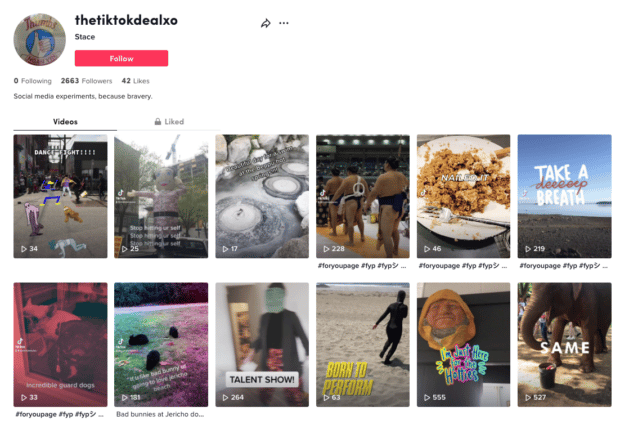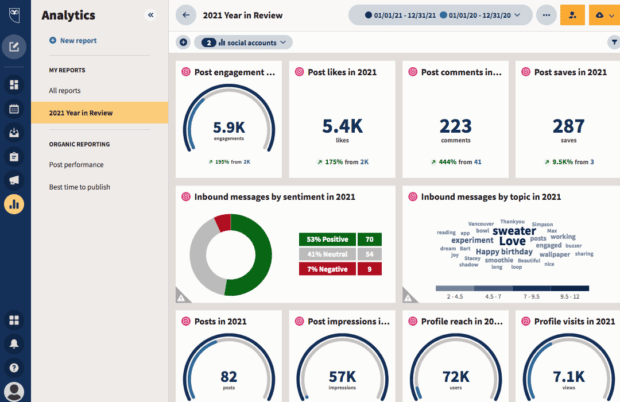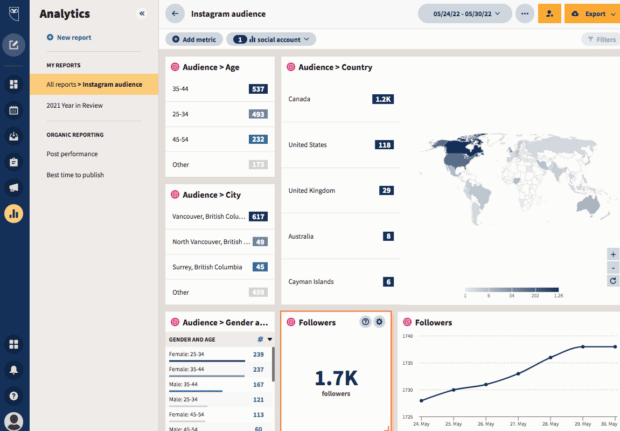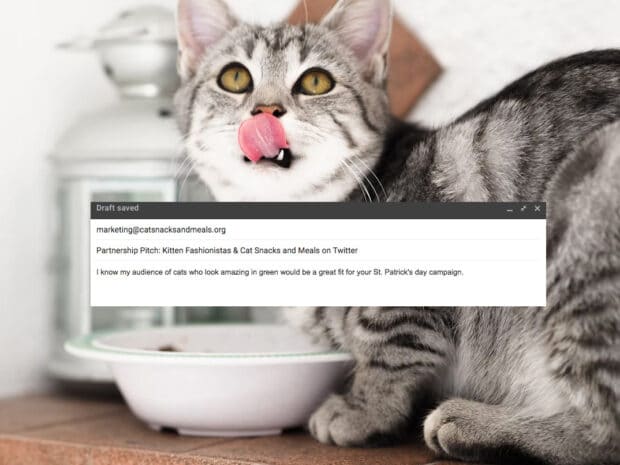Brand Pitch Guide for Creators: Deck and Email Templates
If you’re an influencer, there are a lot of different ways you can use your influence. Convincing people that Crocs are cool again, for instance. One of the more appealing ways to wield your power, IMO? Making some dang money through brand partnerships by leveraging a really great brand pitch deck.
Let’s back up, though. If you’re new to the influencer game, you might be wondering: “How exactly do you get those brand partnerships?” or “Can I please have one?”
Sure you can! All you have to do… is ask.
Because an engaged audience and a great grid are only going to get you so far. The real key to landing the collab of your dreams is to perfect the art of the brand pitch.
While influencers with larger profiles are often approached by companies looking to partner up, partnerships happen the other way ‘round, too, with influencers reaching out to brands to pitch their services.
The good news is, you don’t need to have a six-digit following in order to land a juicy collab. Micro influencers (accounts with between 10,000 and 50,000 followers) and nano influencers (between 5,000 and 10,000 followers) typically have extremely high engagement, which is often what brands are looking for.
And lucky for you, we’ve got a short playbook that will help you learn how to pitch brands as an influencer and a template to help you secure a sweet, sweet influencer marketing partnership of your own.
We’ll teach you how to pitch a brand collaboration so you can make some cold hard cash (or, at very least, earn yourself a pair of free Crocs).
What is a brand pitch deck or email?
A brand pitch is a presentation or email intended to convince a brand to work with you.
More specifically: it means that you (an influencer) are reaching out to a company to ask if they would be interested in partnering on a social media campaign in exchange for either money or product.
Whether you’re making your ask in a well-written email or in a beautifully designed pitch presentation (more on both of those later!), you should clearly explain what you can offer and why you’re the right influencer for the job.
Think of brands as potential investors. They want to see a return on their investment in you, so present them with a business plan (aka your pitch) that shows how you can help them achieve their goals. It’s not exactly a job interview, but it’s not not one either, you know?
Too often, pitches fall flat because they haven’t been thoughtfully crafted and tailored for the specific brand. If you’ve sent lots of pitches and haven’t seen results, it’s time to change your approach.
Your pitch should include:
- A brief intro to who you are
- Analytics and stats from your account
- Details on any other experience you’ve had with brand partnerships in the past
Importantly, it should be short and sweet. Keep it simple and direct — save the flowery language for slam poetry night.
One more key thing: try to find the company’s most appropriate person to address your pitch to. Reaching the marketing specialist or the head of partnerships is going to be more helpful than throwing it into the vague “to whom it may concern” pile.
How to pitch brands as a micro influencer (or any type of creator)
It doesn’t really matter what you’re doing on social: the way you reach out to brands (as a micro influencer or a macro one) for partnership opportunities will follow pretty much the same structure. Whether you’re a vegan-junk-food influencer or a “funny dog groomer,” here’s how your brand ambassador pitch should break down.
1. Start with a strong subject line
A recent Adobe survey found that 75% of all emails never get read. (A separate study is required to find out what percentage of those unread emails are forwards from your aunt.)
The point: Getting someone’s attention and convincing them to actually open and read your email is an accomplishment in and of itself. Your subject line is your first impression and your chance to pique the reader’s interest. Don’t rush it!
Your subject line should:
- Be clear and concise
- State the benefit to the brand
- Be personalized (no copying and pasting!)
- Create a sense of urgency
Basically, every single word of this pitch needs to be thoughtfully composed — from subject line to sign-off. Take your time and get it right.
2. Show off your social profile
Introduce yourself (keep it brief!) and direct their attention to your profile so they can see what you do firsthand.
You’re reaching out to this brand because you think your social presence will do them some good — so make sure you’re sharing a link to your account right off the bat.
It’s the quickest way to introduce yourself and showcase your personal brand. After all, if you’re positioning yourself as a social influencer, your account should align with everything else that you’re saying in your pitch.
3. Share stats that prove you’re the real deal
There are plenty of horror stories out there of brands that have been burned by influencers with fake followers. If you can’t show that you’re credible, nobody will want to work with you. So present your own proof of legitimacy before they can blink twice.
To show you’re a real influencer with real, active followers, it’s a good idea to include these stats in your media kit:
- Engagement rate: The best influencers aren’t always the ones with the biggest followings; they’re the ones with the most engagement. Show that you have a loyal, sustained following that enjoys your content by sharing data around your likes, comments, and shares.
- Monthly views: Sharing average monthly views shows that you have consistent interest from your followers. Can you also show year-over-year growth? All the better.
- Follower growth: If you can show strong, consistent follower growth within the last year, you’ll be able to offer a data-based prediction of the potential future reach of your content. Brands look for steady growth—you’ll raise eyebrows if there’s a huge follower spike for no reason or if your engagement/follower ratio is off.
- Conversion rates: Brands love to see metrics like conversion rates: it shows that you can inspire action. If you use the URL feature on your Instagram Stories or operate an Instagram Shop, be sure to include conversion rates.
4. Touch on ‘the three Rs’ of influence
Just sending a note that says, “soooo a partnership? how ‘bout it?” is not going to cut the mustard in the hyper-competitive influencer economy. You need to sell yourself as the perfect collaborator by touching on the three Rs: relevance, reach, and resonance.
Following this structure is a great way to make sure that you include all the important biz details that a brand is looking for.
- Relevance: You’re sharing content that is relevant to the brand you’re pitching, and your audience demographics match their target market. Sure, you’re going to build brand awareness using your thousands of followers — but are those followers going to be interested in the specific brand you’re pitching? This is also a chance to highlight what you love or admire about a brand or product and outline how your values align with theirs.
- Reach: If you already haven’t made it crystal clear when you shared your analytics, outline just how many people you estimate you could reach. Base this number in reality — over-promising and under-delivering is not the way to make friends in this business.
- Resonance: Explain how you expect your content will resonate with the brand’s desired audience. What level of engagement do you expect to get from your partnership project? Again, base this prediction in reality and avoid wild speculation or firm promises. Guaranteeing 5,000 comments and only seeing five trickle in is a recipe for a nervous breakdown.
5. Share examples of any past partnerships
Prove that you can deliver on the goods — and that you have with past partners.
It’s just like applying for a job: you fill your resume with relevant gigs to show you know what you’re doing. (E.g., if you’re applying for that big cryptozoology gig, you’d better mention your internship at Bigfoot Camp!)
Plus, sharing previous brand partnerships shows you’re experienced and proves that other brands have trusted you in the past.
If you’ve never worked with a brand before, is there any other relevant experience you might be able to share? Maybe you helped a friend promote their music festival with a post or endorsed a glow-in-the-dark toothbrush in a post that went gangbusters. Brag about it!
Format your partnership mentions like this:
- Name the brand or product (or just the industry if you don’t have permission)
- Give a one-liner on how you worked with them
- Share success metrics, revenue accrued, or other outcomes
6. Outline specifics on how you want to work together
You don’t want to pitch a full-on campaign at this point, but a brand pitch should include at least a sentence or two outlining how you’d like to work together.
Show them that there’s a reason you’re reaching out and that you’ve done your homework.
For example, if you know this cat food brand does an annual St. Patrick’s Day campaign, and you can reach one of their target demographics (cats that look good in green), then say that. You should frame your idea in a way that clearly states the benefit to the brand.
This is a nice place to drop in a genuine compliment about why you want to work together. (Besides that sweet, sweet cash, of course.)
7. Sign off with next steps
Here it comes! The grand finale of your email, where you wrap up and share your pitch’s call-to-action: what are you hoping to get your reader to do next?
Whether you’re cold-emailing or you’ve been introduced through someone else, you should aim to set up a call or in-person meet-up. Be specific (but brief) about what you’d like to accomplish in that meeting.
Some influencers like to include compensation and rates right in the pitch email, but it’s OK to save the pricing discussion for when you know more about the brand’s goals and needs.
That’s it! Email over! You’ve done all you can to show that you’re a business-minded, results-driven influencer and increased your odds of getting a response.
Resist the temptation to attach an animated gif or pick a “fun font.” Just give it a thorough proofread (maybe even ask a friend to give it a once-over for good measure), cross your fingers, and hit that send button.
Brand pitch email template
Finding the right words can be stressful — even for professional content creators. That’s why we made this template to get you started. It’s like Mad Libs but, you know, business.
SUBJECT: Partnership Pitch: [influencer name] & [brand name] on [social network name]
Dear [insert name of PR or social media manager contact],
My name is [insert name], and I’m [describe yourself in 5 words or less]. [Describe what you do in 2 sentences or less].
In the past [insert number of years], I’ve grown my following on [insert social network with link to your profile] to [insert number of followers]. My average engagement rate is [insert %].
I’m reaching out because I’m planning content for [insert time period]. In particular, [describe content in more detail].
Would [insert brand] be interested in partnering with me to create this content? My audience is highly interested in [describe specific products or something about the brand that your followers connect to] and would love to learn how [brand] can improve their [insert benefit, e.g., wardrobe, shopping habits, bike safety, workout routine, etc.].
As well, your values of [specify] align with my own. I’ve admired [brand] and [insert genuine compliment].
I’ve worked with [insert industry] brands in the past on similar kinds of content. Here are some examples with accompanying results:
[Brand 1]
- [Insert links to campaign content]
- [Insert positive results]
[Brand 2, if available]
- [Insert links to campaign content]
- [Insert positive results]
If you’re open to working together, I’d love to set up a time to talk further over the phone [or in person, if you’re located in the same location].
Until then, thank you for your time, and have a great day!
[influencer name]
Brand pitch deck template
Sometimes, words just don’t cut it. A brand partnership pitch deck — a multi-page, beautifully designed PDF that covers all of the same points that we discussed above — is a visual way to package your case.
When should you use a brand pitch deck? If you’re reaching someone who might not be the final decision maker, a deck can be a tool for your contact to use in their pitch for your pitch. (Pitches on pitches on pitches!)
Your pitch deck’s branding can also make you look more professional or business-like, so if you’re reaching out to a big fancy organization or luxury brand, a pitch deck might be the way to go.
Some key things to keep in mind when you’re designing your brand pitch deck:
- Keep it short. A brand pitch deck should be no longer than 10-15 pages. The reader should be able to get the gist of your pitch without getting bogged down in time-consuming details. (Docusend reports that readers spend an average of just 2 minutes and 45 seconds reading a pitch deck!)
- Keep it snappy. Text should be short and to the point — choose bullet points over paragraphs, infographics and chunky numbers over detailed graphs or charts.
- Keep it on-brand. Align the graphic design with your visual identity. If your Instagram account is all about a dreamy pastel lifestyle, your deck should be designed with the same palette and vibe.
We’ve created a template for you to use for your brand pitch deck (yeah, we’re sweethearts, deal with it!) — just click the link below to snag your own copy:
If you’d rather start from scratch, here’s a suggested outline to guide you:
Page 1: Title
A captivating image and title like [Your Name] x [Brand Name]
Page 2: About You
Bullet-point intro to you and your accounts, with your most impressive stats included. A screenshot of your social profile here might be a nice touch!
Page 3-4: Analytics
Share your most impressive numbers: follower count and growth rate, engagement rate, monthly visits, conversion rate, etc.
Page 5: About Your Audience
Bullet-point intro to your audience: share relevant demographic details.
Page 6: Why This Partnership?
A bullet-point explanation of how and why you think this would be a valuable collaboration.
Page 7-8: Past Collaborations
A quick summary of 2-3 similar partnerships you’ve done in the past, ideally with some photos or screenshots. Be as specific as you can about the KPIs and metrics!
Page 9: Rates and/or Next Steps
Any details about how to move forward with next steps, including rates if you want to share at this stage.
It’s scary to put yourself out there, but we believe in you! And if you want to level up your social game while you wait to hear back from your future brand partners, we’ve got plenty of resources and blog posts to help. Check out our guide to editing Instagram photos like a pro, freshen up your content plan, or explore how a scheduling tool can help you post at the best time and optimize your reach.
Influencer marketing is easier with Hootsuite. Schedule posts, engage with your fans, and measure the success of your efforts. Try it free today.
The post Brand Pitch Guide for Creators: Deck and Email Templates appeared first on Social Media Marketing & Management Dashboard.
Categories
- 60% of the time… (1)
- A/B Testing (2)
- Ad placements (3)
- adops (4)
- adops vs sales (5)
- AdParlor 101 (43)
- adx (1)
- algorithm (1)
- Analysis (9)
- Apple (1)
- Audience (1)
- Augmented Reality (1)
- authenticity (1)
- Automation (1)
- Back to School (1)
- best practices (2)
- brand voice (1)
- branding (1)
- Build a Blog Community (12)
- Case Study (3)
- celebrate women (1)
- certification (1)
- Collections (1)
- Community (1)
- Conference News (1)
- conferences (1)
- content (1)
- content curation (1)
- content marketing (1)
- contests (1)
- Conversion Lift Test (1)
- Conversion testing (1)
- cost control (2)
- Creative (6)
- crisis (1)
- Curation (1)
- Custom Audience Targeting (4)
- Digital Advertising (2)
- Digital Marketing (6)
- DPA (1)
- Dynamic Ad Creative (1)
- dynamic product ads (1)
- E-Commerce (1)
- eCommerce (2)
- Ecosystem (1)
- email marketing (3)
- employee advocacy program (1)
- employee advocates (1)
- engineers (1)
- event marketing (1)
- event marketing strategy (1)
- events (1)
- Experiments (21)
- F8 (2)
- Facebook (64)
- Facebook Ad Split Testing (1)
- facebook ads (18)
- Facebook Ads How To (1)
- Facebook Advertising (30)
- Facebook Audience Network (1)
- Facebook Creative Platform Partners (1)
- facebook marketing (1)
- Facebook Marketing Partners (2)
- Facebook Optimizations (1)
- Facebook Posts (1)
- facebook stories (1)
- Facebook Updates (2)
- Facebook Video Ads (1)
- Facebook Watch (1)
- fbf (11)
- first impression takeover (5)
- fito (5)
- Fluent (1)
- Get Started With Wix Blog (1)
- Google (9)
- Google Ad Products (5)
- Google Analytics (1)
- Guest Post (1)
- Guides (32)
- Halloween (1)
- holiday marketing (1)
- Holiday Season Advertising (7)
- Holiday Shopping Season (4)
- Holiday Video Ads (1)
- holidays (4)
- Hootsuite How-To (3)
- Hootsuite Life (1)
- how to (5)
- How to get Instagram followers (1)
- How to get more Instagram followers (1)
- i don't understand a single thing he is or has been saying (1)
- if you need any proof that we're all just making it up (2)
- Incrementality (1)
- influencer marketing (1)
- Infographic (1)
- Instagram (39)
- Instagram Ads (11)
- Instagram advertising (8)
- Instagram best practices (1)
- Instagram followers (1)
- Instagram Partner (1)
- Instagram Stories (2)
- Instagram tips (1)
- Instagram Video Ads (2)
- invite (1)
- Landing Page (1)
- link shorteners (1)
- LinkedIn (22)
- LinkedIn Ads (2)
- LinkedIn Advertising (2)
- LinkedIn Stats (1)
- LinkedIn Targeting (5)
- Linkedin Usage (1)
- List (1)
- listening (2)
- Lists (3)
- Livestreaming (1)
- look no further than the new yorker store (2)
- lunch (1)
- Mac (1)
- macOS (1)
- Marketing to Millennials (2)
- mental health (1)
- metaverse (1)
- Mobile App Marketing (3)
- Monetizing Pinterest (2)
- Monetizing Social Media (2)
- Monthly Updates (10)
- Mothers Day (1)
- movies for social media managers (1)
- new releases (11)
- News (72)
- News & Events (13)
- no one knows what they're doing (2)
- OnlineShopping (2)
- or ari paparo (1)
- owly shortener (1)
- Paid Media (2)
- People-Based Marketing (3)
- performance marketing (5)
- Pinterest (34)
- Pinterest Ads (11)
- Pinterest Advertising (8)
- Pinterest how to (1)
- Pinterest Tag helper (5)
- Pinterest Targeting (6)
- platform health (1)
- Platform Updates (8)
- Press Release (2)
- product catalog (1)
- Productivity (10)
- Programmatic (3)
- quick work (1)
- Reddit (3)
- Reporting (1)
- Resources (34)
- ROI (1)
- rules (1)
- Seamless shopping (1)
- share of voice (1)
- Shoppable ads (4)
- Skills (28)
- SMB (1)
- SnapChat (28)
- SnapChat Ads (8)
- SnapChat Advertising (5)
- Social (169)
- social ads (1)
- Social Advertising (14)
- social customer service (1)
- Social Fresh Tips (1)
- Social Media (5)
- social media automation (1)
- social media content calendar (1)
- social media for events (1)
- social media management (2)
- Social Media Marketing (49)
- social media monitoring (1)
- Social Media News (4)
- social media statistics (1)
- social media tracking in google analytics (1)
- social media tutorial (2)
- Social Toolkit Podcast (1)
- Social Video (5)
- stories (1)
- Strategy (603)
- terms (1)
- Testing (2)
- there are times ive found myself talking to ari and even though none of the words he is using are new to me (1)
- they've done studies (1)
- this is also true of anytime i have to talk to developers (1)
- tiktok (8)
- tools (1)
- Topics & Trends (3)
- Trend (12)
- Twitter (15)
- Twitter Ads (5)
- Twitter Advertising (4)
- Uncategorised (9)
- Uncategorized (13)
- url shortener (1)
- url shorteners (1)
- vendor (2)
- video (10)
- Video Ads (7)
- Video Advertising (8)
- virtual conference (1)
- we're all just throwing mountains of shit at the wall and hoping the parts that stick don't smell too bad (2)
- web3 (1)
- where you can buy a baby onesie of a dog asking god for his testicles on it (2)
- yes i understand VAST and VPAID (1)
- yes that's the extent of the things i understand (1)
- YouTube (13)
- YouTube Ads (4)
- YouTube Advertising (9)
- YouTube Video Advertising (5)





